El Laberinto del Fauno (inappropriately translated overseas as Pan’s Labyrinth) was independently written, produced and directed by Guillermo del Toro, with a budget of approximately 16 million dollars. The film’s effects were created by Everett Burrell’s CafeFX — which animated the digital effects — and David Marti’s DDT Efectos Speciales — which built the extensive practical effects. Since the beginning of the project, Del Toro established Victorian Illustrator Arthur Rackham’s art pieces — which represent fantasy characters in dark and seemingly emotionless atmospheres — as the main visual inspiration for the film.
In the final film, the first (and interestingly enough, last) creature to be seen is a fairy (la hada) — in the form of a fictitious Phasmid, designed combining elements from two stick insects (nicknamed Cheech and Chong) kept at the CafeFX facility as reference. The inclusion of a stick insect as a visual element was inspired by a mounted Malaysian stick insect that Del Toro had bought in his childhood. The creation of the insect fairy was assigned to CG supervisor Akira Orikasa and animation supervisor Ron Friedman. When the creature visits Ofelia in her bedroom, she shows it an illustration of a fairy — and it promptly transforms into a configuration similar to the drawing. “Guillermo wanted the fairy to be very girly,” said visual effects supervisor Edward Irastorza, “so we tried to get some female characteristics into the stick bug before it transformed. When Ofelia shows the bug the picture of a fairy, the stick bug combs its wings back, kind of like a human looking in a mirror admiring her own butt. That was the very first humanoid movement that it did, before transforming.” The actual transformation was achieved with keyframe animation, as explained by visual effects supervisor Everett Burrell: “we used a procedure in Softimage XSI called ‘shrink wrap’. It wasn’t a traditional morph by any means. We took totally different geometry and wrapped it around the fairy, like a fairy wearing a stick bug suit.”
Curiously, the stand-in for the digital fairy was a Bratz doll, painted green and with its hair cut off. The actual fairy, designed by Sergio Sandoval, was initially conceived during the production of Hellboy (a prototype appears, unseen, inside Rasputin’s gauntlet). It presents a similar colour scheme to its stick bug form and a faintly translucent skin. Two other fairies are also seen, in blue and red variants. The design tried to stray from overtly traditional configurations. “I wanted them to look like little monkeys,” Del Toro said “like dirty fairies. They eat meat. They scratch all the time.” Artists at CafeFX suggested the concept of leaf-like wings, an idea Del Toro approved immediately.
According to Burrell, the animation of the fairies was inspired by several Harryhausen characters. “We looked at the Homunculus from The Golden Voyage of Sinbad, and the Trog from Sinbad and the Eye of the Tiger,” he told CGSociety. “We tried to get those Harryhausen moments.” There was also a difference in behaviour between the first green fairy and the other two: whereas the former was more humane in its behaviour (dancers were even used as visual reference), for the latter characters “we were thinking of primate behavior” said animator Ron Friedman, “or even cavemen. It was as if they hadn’t yet learned the refinements of how to carry themselves.” Ultimately, he adds, “it was a fine line trying to incorporate something that felt elegant, but still animalistic and not totally human.”
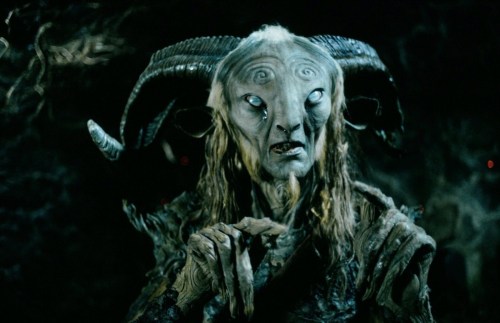
The fairy leads Ofelia to the core of the Labyrinth, where the Faun (el Fauno, or Monstruo Cabrion) is revealed. The creature was inspired by recurring dreams experienced by Del Toro in his youth. In an interview with The Guardian, the director recalled: “We have a small gothic temple in Guadalajara — that’s like you having an Aztec pyramid in central London. Some people from Opus Dei erected this temple in the middle of my city and it’s called the Expiatory Temple. So I would hear the temple bells ringing midnight, and as they started chiming, I would see the human hand of the Faun come out from the armoire, then the smiling face of a goat, and then the hairy leg of a goat. I would clearly see him pulling his body out of the armoire and I would start screaming, repeatedly, every night that I slept in that bed.”
VOICE
It’s you — it’s you! You’ve returned!The VOICE is cold and full of sibilance. The cloud moves aside…
On its hind quarters, in the shadows, is the twisted and sinister figure of a FAUN. He’s covered in roots and moss.
Ofelia backs away, speechless.
-Guillermo del Toro, El Laberinto del Fauno script (translated)
In the film, the Faun is played by Doug Jones, who had already collaborated with Del Toro on Hellboy (in the role of Abraham Sapien). Although Jones’ voice was replaced with Pablo Adan’s in post-production, the actor still provided correct lip synchronization. He explained to CHUD.com: “I was comforted to know that there would be a voice actor to save me. In fact, Guillermo said, ‘aw, you can count to ten for all I care, just give me the right pauses, we’ll be fine.’ But I couldn’t leave him with my lips, going one two three four… and have them try to sync it up later, it would be like a bad Godzilla dub. And I had an English translation of every scene, so I was able to figure out the sentence structure and where to emphasize.”
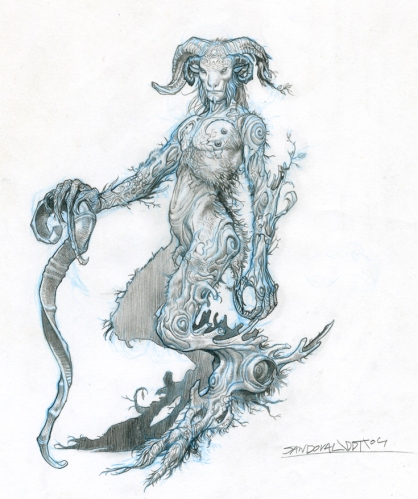
Responsible for the character’s design was conceptual artist Sergio Sandoval in collaboration with the director. The Faun combines traits of a human and a goat, with bark-like skin and features on its body. On the Faun’s skin are spiral engravings, similar to those found in several character designs in the Hellboy films, including Hellboy himself and Sammael. Unlike those, however, the Faun’s engravings represent the Labyrinth itself. “We carved in spiral engravings on his face and chest,” Marti said, “representing the Labyrinth in ancient ritual markings. Whenever Doug was resting on set, he looked like a weird wooden effigy, not a living animal.”

The Faun was sculpted by David Marti (for the head) and Pau Loewe, Arturo Balseiro, Jose Menenses and Nelly Guimaras (for the body). DDT built two suits and an animatronic head extension — an understructure containing the mechanisms animating the Faun’s face — which was then covered in foam latex skin. Only Jones’ lower head portion was directly seen in make-up. The actor also wore dental prosthetics. Marti recalled: “it took about two hours to put on the head, then two more hours to fit him in the suit. We added the horns last, on set, because it was difficult for Doug to fit through the door frames wearing those.” The motion of the creature’s eyes, nose and ears was controlled by servo motors (devised by mechanical designer Xavi Bastida) contained in the horns themselves. The position of the Faun’s eyes only allowed limited visibility through small openings in the creature’s tear ducts. A separate neck piece was applied at the collarbone and blended with the head make-up.
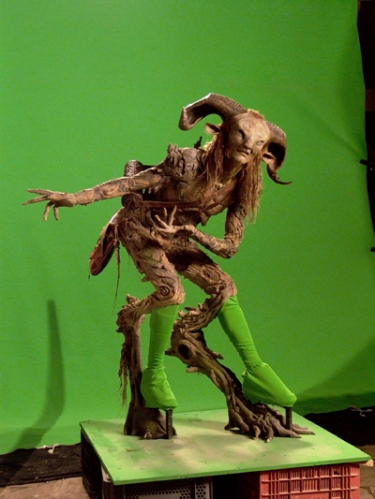
The Faun’s legs are digitigrade, with a rather extended metatarsal section. In order to properly portray them in the film, the special effects team combined practical and digital effects, with a system devised by the director himself: Jones wore leg extensions that covered his thighs and then protruded backwards, simulating the anatomy of the creature, only to reconnect at the feet. To puppeteer them, Jones simply had to move his legs in different manners, depending on the kind of motion a specific shot requested. The unsuited portions of his legs, when seen in the shot, were covered with cloth of varying colours (depending on the shot), which enabled CafeFX to remove them and present the Faun’s legs as intended. Clean plates were used to recreate obscured portions of the background. When the Faun was seen from the front, however, almost complete digital legs were employed. Irastorza said: “on side shots it was fairly easy for us to clean up [the Faun]’s legs. The prosthetic legs were behind Doug’s stilts, and Doug’s shin area was covered in green, blue or black material, depending on where we were shooting. Wherever we had full frontal shots, though, we had to completely create digital legs because Doug’s legs obscured the prosthetic.” In the full suit, Jones as the Faun stood almost seven feet tall.
The last touches added to the creature were digital enhancements for certain expressions. Irastorza recalled: “Doug had pretty good freedom of movement on the set. Most of Pan’s expressions were practical, but when he squinted, he never completely closed his eyes, so we helped him out there digitally and added minor facial expressions.”
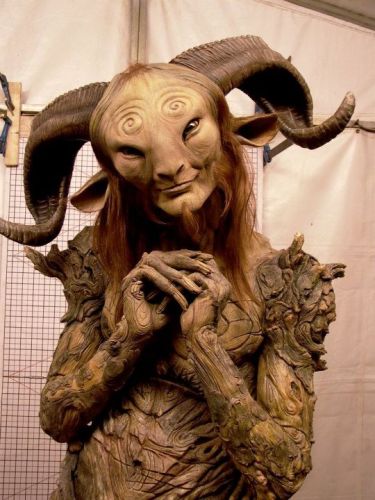
Throughout the course of the film, the Faun actually undergoes a rejuvenation process. Marti explained: “the regeneration was subtle. In early scenes, we covered [the Faun] with a skin overgrown with moss and little branches. Then, as [the Faun] appeared over eight scenes, we removed pieces to make him look cleaner.” Other details were added to enhance this progression: the Faun’s skin is initially aged, and its eyes display a cataract design — only to rejuvenate progressively. The colour of the creature’s hair also changes from pale golden tones to earth-like browns, and its broken left horn progressively grows back to its original state. This artistic choice was not explained by Del Toro; even members of the crew conceived their own explanations. “My interpretation is that [Ofelia]’s been away from the underworld for so long [that it] is waiting for her return, and decaying in her absence. I’m a reflection of that. The more tests she passes, the more she believes her destiny and trusts her instincts, the more young and powerful I become.”
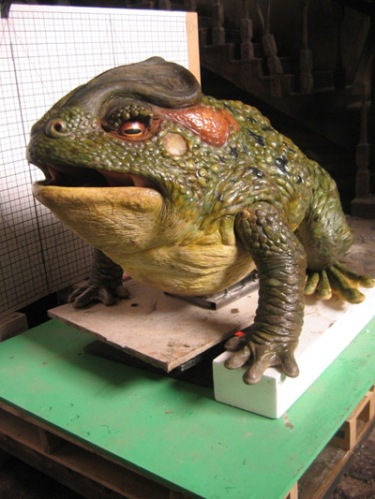
In the first task assigned by the Faun, Ofelia faces a giant toad (el sapo), an inclusion in the film inspired by the 1953 film The Maze. Originally conceived to be much smaller, the toad was sculpted by Montse Ribé (Marti’s wife), Alberto Alberto Hortas Lopez, Lorenzo Tamburini, and Aleix Torrecillasand. It was built as a five-foot long animatronic. It was puppeteered on set by Ribé herself through a hole in the set floor. The toad had a fully articulated head, as well as bladders to inflate its stomach and ear recesses. As complex as the animatronic was, its performance on set proved to be unfeasible; as such, CafeFX was assigned the task to duplicate the toad digitally. Where the original intention was to use visual effects only for the tongue and for the creature’s demise — when it turns inside out — the final film features mostly the digital version of the toad. When the creature vomits its insides out, the sequence is entirely digital — and then cuts to the practical ‘deflated toad’ and phlegm. Marti recalled: “The phlegm was solid gelatin. It was so heavy, we couldn’t prepare it earlier and transport it to set. Instead, we brought the mold to set, filled it with gelatin and opened it in place.”
Ofelia is at first reluctant to complete the second task, due to the increasingly worse condition of her mother. The Faun gives her a Mandrake root that, in a bowl of milk and fed with blood, heals Carmen; Ofelia uses the Mandrake actually after the second task. The creature was brought to the screen as a featureless dummy at first, and then as a cable-controlled and radio-controlled puppet — mechanized by Bastida. The controls for its mechanisms were concealed inside the bowl of milk the Mandrake is put in. Many shots of the creature were also digital. “The Mandrake was real only in the scenes where it was tossed around,” Irastorza said. “Guillermo wanted the movement to be a little more fluid, so we used the puppet more as reference and re-created it digitally.” The Mandrake also mimics Carmen’s movements, a complex animation sequence. “When she turned from side to side and adjusts her feet, the mandrake had to mimic those actions almost exactly,” Friedman said. “But because there’s a time delay the audience sees the mother moving first, so we had the mandrake perform the same thing with a broader movement to move the audience’s eyes there.”
It is during the second task that Ofelia unwillingly awakens the Pale Man (el Hombre Palido), a metaphoric embodiment of the fascist government and the corrupted Church. The Pale Man was originally envisioned as a floating child-like ghost with a visible nervous system (aptly named Fantasma de Nervios, ‘Nerve Ghost’) able to eject skeletal horse jaws from its mouth. As the conceptual stage progressed the Nerve Ghost became a more physical entity and evolved into the Pale Man. Again played by Doug Jones, the monster “represents fascism and the Church eating children, when they have a perversely abundant banquet in front of them,” Del Toro said. “There is almost a hunger to eat innocence.” In addition, the Pale Man represented gluttony. In conceiving the character, Del Toro settled on a rule: it could “engage in gluttony only if a kid indulged in gluttony,” Del Toro said. “If a kid broke the rule of not eating, then he could.”
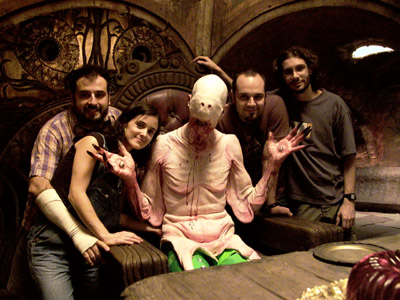
The director was also really specific that the same actor ought to play both the Faun and the Pale Man. Jones commented: “Guillermo wanted the same actor to play [the Faun] and the Pale Man because, as he said on set, ‘you know, in my sick mind I think that the Pale Man is kind of a creation of Pan.’ And that makes sense, because he’s part of one of the tests Ophelia had to pass that Pan set up for her.”
The creature was visually influenced by Francisco Goya’s painting Saturn Devouring His Son (1823) and, curiously enough, by an acquaintance of Del Toro and Irastorza. The latter commented: “the idea was for a man who had been very fat and lost a lot of weight quickly. This was based on a producer Guillermo and I had worked with, who was very old and had sagging, disgusting skin. This guy had been around for so long, we used to say he had been a production assistant on Battleship Potemkin — at least, that was the joke we made, lovingly.” Del Toro was also inspired by a quick loss of weight he had experienced.
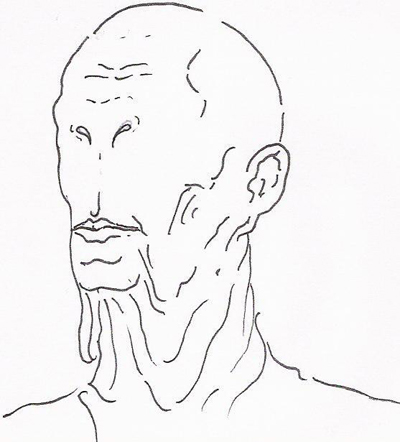
Originally, the Pale Man’s face was to resemble an old man’s — but Del Toro eventually discarded the idea, deeming it “trivial.” To emphasize the creature’s hunger, the director decided to render the face “blank” and eyeless. The concept of the creature’s eyes laid on a plate before him was influenced by a statue of St. Lucy Del Toro had seen in his childhood, whereas the eyes on the palms were inspired by a poster for the 1979 Italian horror film Phantasm (Fantasmi) — where the eyes of a screaming woman can be seen flashing through the hands covering her face.
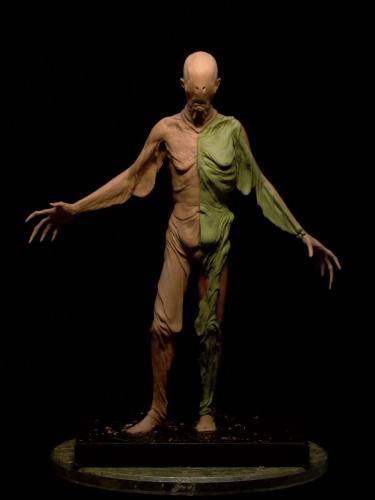
Similarly to the Faun, the Pale Man was brought to the screen with an amalgamation of practical and digital effects. Marti recalled: “we had two ideas to achieve the Pale Man: one was to have a skeletal puppet in front of the puppeteer, like bunraku puppetry from Japanese theater. The other was to do him as a make-up. Arjen Tuiten, one of our lead artists, did two maquettes — one for a make-up, another as a puppet — and Guillermo chose a mix of both. We did the upper part of the body as a make-up and the legs as a puppet. We put green legs on Doug Jones, then applied skinny legs on top. It worked perfectly with frontal shots; but in profiles, CafeFX had a lot of work to do.”
The Pale Man was sculpted by Arjen Tuiten and Arturo Balseiro Santos, both of whom also contributed to the make-up applications. To portray the creature’s head, a vacuform understructure was positioned on Jones’ head (flattening his nose in the process), and then covered with foam latex skin. Again, only Jones’ lips were directly visible in make-up, and the actor wore dental prosthetics portraying the Pale Man’s small, crooked teeth. Most of the Pale Man’s skin was foam latex, whereas the hanging folds of drooping skin on its face and arms were cast in silicon gel. Making this mixture of materials blend under a single paint scheme proved rather complex; Marti explained: “it was almost impossible to make foam latex look like silicone. We used transparent washes on the foam, and then overpigmented the silicone, trying to avoid a waxy look to make the materials match.”
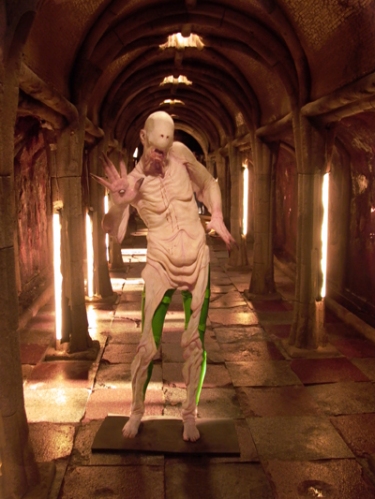
Jones could only see through the Pale Man’s nostrils while cross-eyed. “I had no eyes in my head,” Jones said, “since they were in my hands, but the nostrils were up kinda high and kinda big, and that’s what I looked out of. I could see out of the right nostril with my left eye and the left nostril with my right eye. So it was a disorienting cross-eyed thing going on.” To ease the performance and shooting schedule, the Pale Man was also built as a featureless dummy for the scenes where the creature sits still, slumbering, at its banquet. An insert animatronic arm was built to portray the creature inserting its eyeballs in its palms. In post-production, CafeFX also added a blinking animation; the eyes were digitally augmented in all the shots featuring them in close-up.
When the Pale Man grabs and violently devours the two fairies, Jones enacted the sequence by biting condoms filled with artificial blood, which were then replaced by digital fairies in post-production. The most complex digital augmentations in regards of the creature were however used in profile views of the creature walking. CafeFX created a digital double of the Pale Man’s waist and legs, animated them matching Jones’ performance, and rotoscoped them accurately. As in the Faun’s case, clean plates were used to recreate the missing portions of the background.
Compositing Supervisor Tom Williamson resumed the crew’s feelings towards the film concisely: “I’ve worked on 40 motion pictures,” he said, “and I can count the ones I’m proud of on one hand. At this point, Pan’s Labyrinth is number one.”
For more images of the Creatures from the film, visit the Monster Gallery.

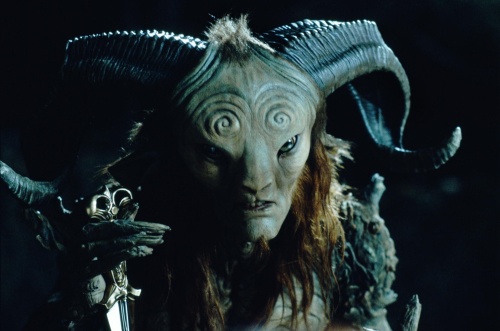
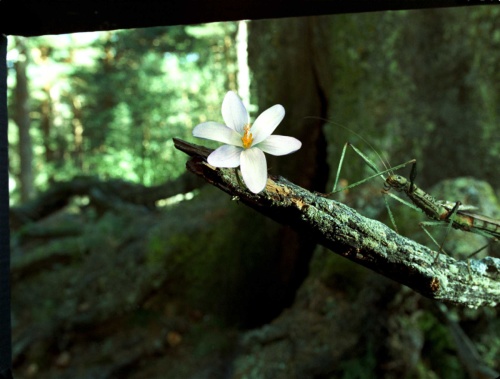
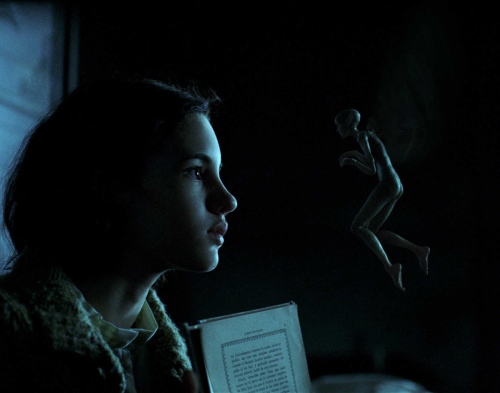
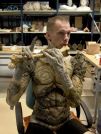
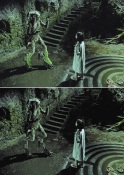
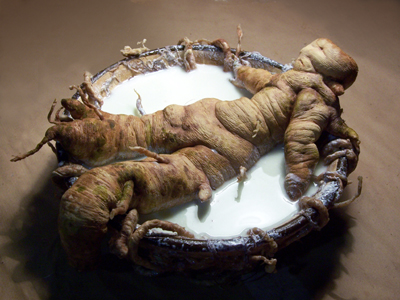
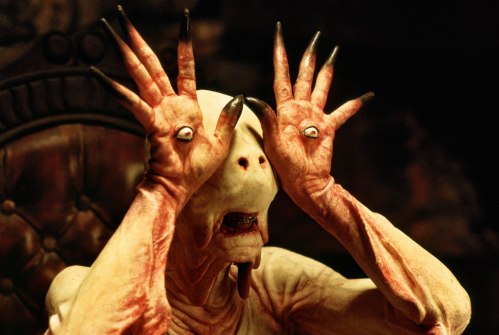
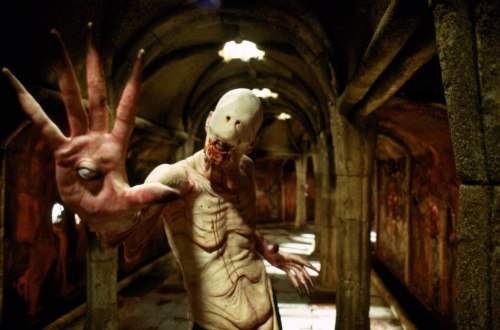
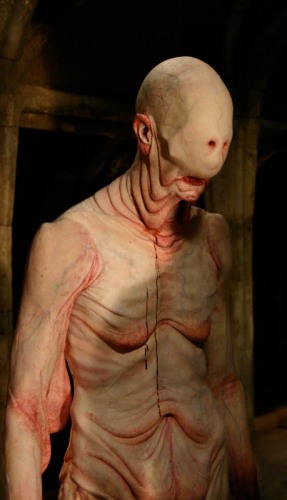


[…] practical or digital, whereas others employed both effects systems. Certain expedients used in Pan’s Labyrinth — such as the use of green screen creature suit portions that would be erased in […]
[…] Monster Legacy – Laberinto del Fauno […]